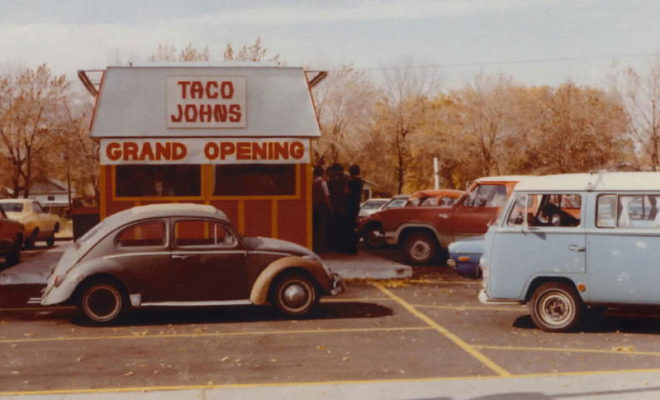Back in 2007, I returned to my Wyoming roots after being away for eleven years, living in several cities across the U.S., from the east coast to the west. Toward the end of my Cowboy State hiatus, I also met the woman who would eventually become my wife, and as luck would have it, she too was a Wyoming native looking to return to Wyoming to raise our family.
We were excited to share our square-shaped state with our newborn daughter, and as my wife and I packed up the U-Haul truck, we began making a list of all of the things we were excited about for our return to Wyoming. It read like a to-do list from Sunset Magazine with trips planned to Yellowstone Park and Devils Tower as the highlights. Scenic drives on the weekend to the local Bighorn National Forest and visits to old friends in off-the-beaten-path small towns also made it to the top of our list. Rounding out our list was a fast-food restaurant, and maybe it didn’t deserve to be included on our scribbled agenda of all-world stops, except for the fact that we had said it in unison – “Taco John’s®!”
To an outsider, the name “Taco John’s®” might scream of a shady back ally taco stand run by an aging Caucasian male, but in Wyoming, Taco John’s® has a cult-like following and a menu of items that are “nearly Mexican food” as some describe it, or as the restaurant advertises, “West-Mex.” Replacing tortilla chips as a traditional Mexican side are the, now famous, Potato Oles® or small tater tots sprinkled with an addictive Southwestern pixie dust of spices. This is just one of the signature items that has made Taco John’s® a staple of Wyoming’s culture. So how did this unorthodox Mexican restaurant get its humble beginnings in Wyoming?
Back in the late 1960’s, a gentleman by the name of John Turner, an Air Force serviceman from F.E. Warren Airforce Base, started a small taco stand with the simple name, The Taco House. Within a year and some initial success, Mr. Turner sold franchising rights to two businessmen from Cheyenne and they changed the name to reflect its owner. Going for a seemingly more marketable title, James Woodson and Harold Holmes changed the name to Taco John’s®.
Much of the initial success was attributed to a blend of spices that John Turner and his wife ground in their basement each week. Customers raved about the flavor and since that time, the spices have remained and are now a trade secret of the restaurant. The success was also directly related to the Turner’s well-regarded customer service. The new taco restaurant stood out in a market of growing ideas for large portions of food that were made-to-order, fast. This became known as the fast food concept.
With the initial success, Woodson and Holmes took the Turner’s recipes and drove their idea to duplicate the taco shacks in small Midwestern towns around Cheyenne. They started with locations in Torrington, Wyoming and Scottsbluff, Nebraska. They also had some interest from franchisees in Rapid City, South Dakota and Des Moines, Iowa who had tried the food while in Cheyenne. Their initial idea to target small towns was a great one as their fast food concept was catching on while many of the early fast food chains were targeting larger, urban areas.
Originally, the Taco House’s logo included a devilish character. After beginning their efforts to market the franchising concept, Woodson and Turner created a logo that included a stereotypical cartoon Mexican character complete with sombrero and a side-kick burro named Pepe. It is a logo I remember adorning some collector’s glasses and the packaging we received from our Gillette, Wyoming restaurant in the 1970’s. That logo was replaced with a more formal Mexican character and the font was changed to a more Southwestern feel in the mid-1990’s. Through those changes, the restaurant concept and the franchise base continued to expand. By the end of the 1980’s, Taco John’s® was growing quickly and had several hundred locations spanning twelve Midwestern states. By the end of the 1990’s, the chain had grown into larger metropolitan areas and expanded to over 450 stores in 25 states.
In the late 1970’s and early 80’s, I remember our small Gillette location and the grainy pictures that depicted the menu items, along with the movable red number that depicted the pricing. Just like a small version of a gas station sign showing the current price of gas. I remember the smell of the place and the taste, just as it tastes today. Not much has changed other than the corporate look and well-done interiors, packaging, and marketing that you would expect of a major fast-food chain. Sadly, what is missing are some of the original menu items that were favorites in our household. Do you remember the Apple Grande®? It was a wild dessert mix of fried tortilla, topped with ground apple pie filling and topped with cheddar cheese and a mix of Cinnamon and Mexican Spices.
Growing up there were two things that created excitement for me about Taco John’s®. One was Taco Tuesday® and the other was getting free tacos from the local restaurant for any A’s I had on my report card. Later, in college, we weren’t able to get those free tacos for A’s, but my A’s were also much less typical. However, my roommates and I did partake often in one of their first meal deals, the Six-Pack and a Pound®. For $5, a couple of poor college kids could share six tacos and a pound of the addictive Potato Ole’s® for just a couple bucks. Their portions never disappointed.
As the company has grown, so has their competition. As the second largest Mexican fast-food franchise behind Taco Bell, the restaurant made an early decision to not try and compete with Taco Bell on price. Instead, they stayed true to their original core menu and offered the same high quality, with larger portions, at a premium price. That decision has served them well, and their loyal audience and growing presence around the country has welcomed new customers to buy into their model and to their consistent menu and service.
With this competition, Taco John’s® and its management are staying true to their history and their growth model and expanding their presence to places that have yet to experience the West-Mex concept. The restaurant is driving growth in and around Denver, one of America’s fastest growing cities, and it is driving growth east of the Mississippi where Taco Bell dominates. There is plenty of room for continued growth for this Wyoming-based and founded business, just like there is always room in my belly for one more Potato Ole®.


Milo Westburg
November 18, 2017 at 11:53 am
My wife and I ate at Taco John’s for the 1st time in 1968 in Bozeman, MT where we were attending Montana State University. We still love it!